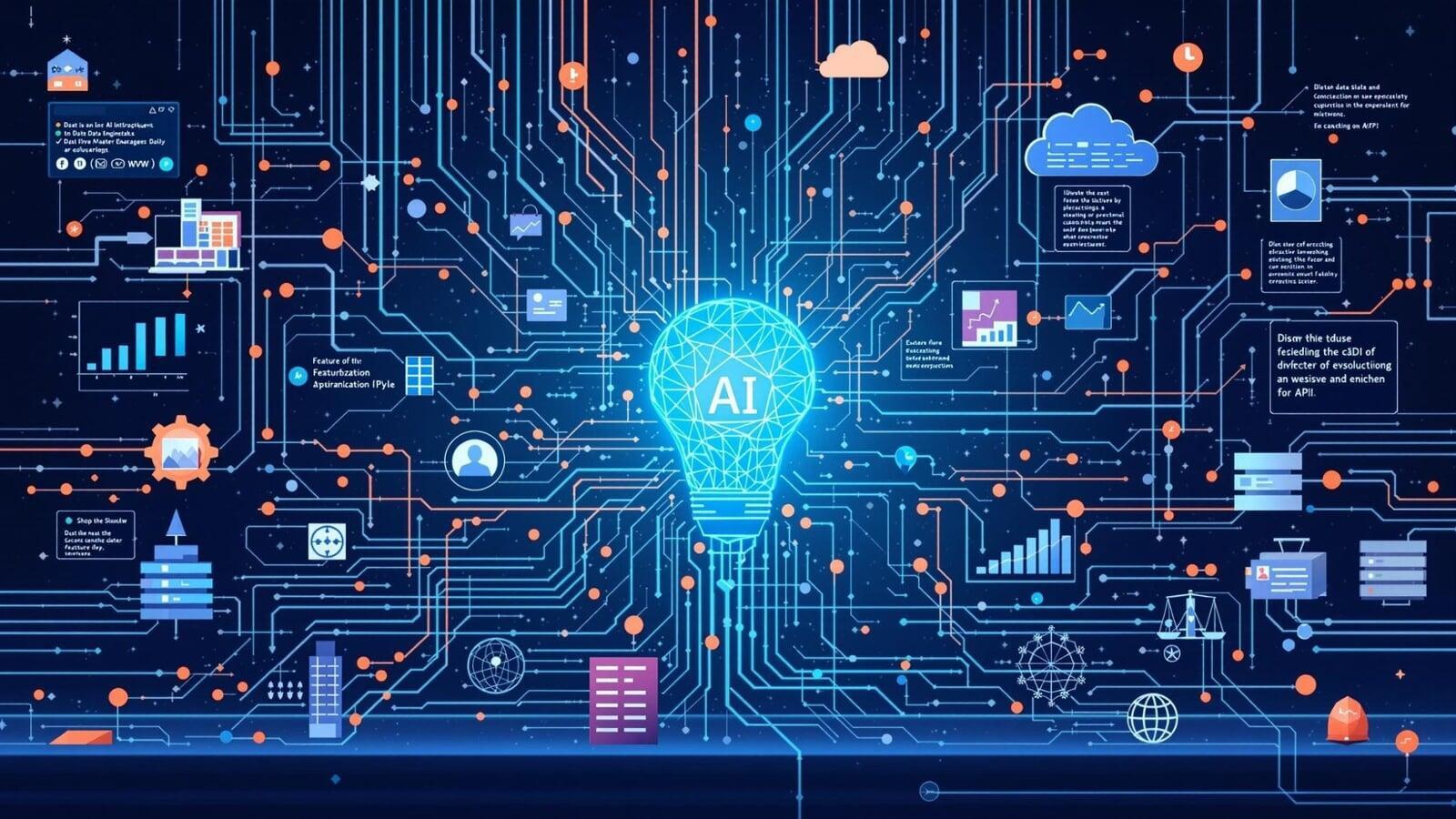Introduction to Modern Data Infrastructure for AI


The success of AI systems heavily depends on the robustness and efficiency of their underlying data infrastructure. As AI models become more sophisticated, the demands on data engineering systems have grown exponentially, requiring specialized knowledge and advanced architectural patterns.
Streaming Data Pipeline Design
Core Components
- Stream processing frameworks (Apache Kafka, Apache Flink, Apache Spark Streaming)
- Real-time message queuing systems
- Event-driven architectures
- Fault tolerance and recovery mechanisms
- State management in distributed systems
Implementation Strategies
- Exactly-once processing guarantees
- Windowing operations for stream processing
- Backpressure handling mechanisms
- Schema evolution management
- Stream-table joins and enrichments
Performance Optimization
- Parallel processing configuration
- Resource allocation strategies
- Throughput optimization techniques
- Latency reduction methods
- Monitoring and alerting setup
Feature Store Implementation
Core Functionality
- Online and offline feature serving
- Feature computation and storage
- Feature versioning and lineage
- Time-travel capabilities
- Access control and governance
Technical Components
- Storage layer architecture
- Serving layer design
- Feature registration and discovery
- Computation layer implementation
- API design and documentation
Operational Aspects
- Cache management strategies
- Consistency guarantees
- Performance optimization
- Resource utilization
- Cost management
Data Quality Monitoring and Validation
Data Quality Framework
- Schema validation systems
- Data consistency checks
- Statistical analysis tools
- Anomaly detection mechanisms
- Quality metric definitions
Monitoring Implementation
- Real-time quality checks
- Historical trend analysis
- Alert generation and management
- Root cause analysis tools
- Automated correction mechanisms
Validation Strategies
- Unit testing for data pipelines
- Integration testing frameworks
- End-to-end testing approaches
- Performance testing methodologies
- Regression testing systems
Efficient Data Preprocessing at Scale
Preprocessing Architecture
- Distributed processing frameworks
- GPU acceleration strategies
- Memory optimization techniques
- Load balancing mechanisms
- Resource allocation strategies
Implementation Techniques
- Feature engineering pipelines
- Data normalization methods
- Missing value handling
- Categorical encoding strategies
- Text preprocessing pipelines
Optimization Methods
- Caching strategies
- Parallel processing optimization
- I/O optimization techniques
- Memory management
- Resource utilization monitoring
Real-time Data Integration
System Architecture
- Event-driven integration patterns
- Microservices architecture
- API gateway implementation
- Service mesh integration
- Data consistency patterns
Integration Components
- Real-time ETL processes
- Change data capture systems
- Data synchronization mechanisms
- Schema mapping tools
- Error handling frameworks
Performance Considerations
- Latency optimization
- Throughput management
- Resource scaling
- Cost optimization
- Monitoring and observability
Infrastructure and Tools
Essential Technologies
- Apache Kafka/Confluent Platform
- Apache Spark/Databricks
- Apache Airflow
- dbt (data build tool)
- Great Expectations
Cloud Platforms
- AWS (Amazon Web Services)
- S3, Kinesis, EMR
- Google Cloud Platform
- BigQuery, Dataflow, Pub/Sub
- Azure
- Data Factory, Event Hubs, Synapse
- Data Factory, Event Hubs, Synapse
Monitoring and Observability
- Prometheus/Grafana
- ELK Stack
- DataDog
- New Relic
- Custom monitoring solutions
Best Practices and Design Patterns
Architecture Patterns
- Lambda architecture
- Kappa architecture
- Data mesh principles
- Data lake design
- Data warehouse modernization
Operational Excellence
- Infrastructure as Code (IaC)
- CI/CD for data pipelines
- Documentation standards
- Version control practices
- Change management procedures
Security and Compliance
- Data encryption methods
- Access control implementation
- Audit logging
- Compliance monitoring
- Privacy protection measures
Career Growth and Opportunities
Role Evolution
- Junior Data Engineer → Senior Data Engineer
- Senior Data Engineer → Lead Data Engineer
- Lead Data Engineer → Data Architect
- Data Architect → AI Infrastructure Architect
- Technical Specialist → Technical Director
Required Skills by Level
- Entry Level
- SQL and Python proficiency
- Basic ETL concepts
- Data modeling fundamentals
- Version control systems
- Basic cloud services
- Mid Level
- Advanced data pipeline design
- Performance optimization
- Distributed systems
- Cloud architecture
- Team leadership
- Senior Level
- System architecture design
- Strategic planning
- Team management
- Vendor evaluation
- Budget management
Industry Applications
- Financial Services
- Real-time fraud detection
- Risk analysis systems
- Trading platforms
- Healthcare
- Patient data integration
- Clinical trial analysis
- Real-time monitoring systems
- E-commerce
- Recommendation systems
- Inventory management
- Customer behavior analysis
Future Trends and Developments
Emerging Technologies
- Hybrid cloud architectures
- Edge computing integration
- Serverless data processing
- AutoML integration
- Real-time AI systems
Industry Directions
- Increased automation
- Enhanced privacy requirements
- Greater real-time processing demands
- Multi-cloud strategies
- Edge computing adoption
Getting Started and Learning Path
Foundation Building
- Learn core programming languages
- Python
- SQL
- Shell scripting
- Understand basic concepts
- Database design
- ETL processes
- Data modeling
- Cloud computing
- Master essential tools
- Version control (Git)
- CI/CD tools
- Cloud platforms
- Container technologies
Advanced Learning
- Specialized technologies
- Stream processing
- Feature stores
- Data quality frameworks
- Real-time processing
- Architecture patterns
- Distributed systems
- Microservices
- Event-driven architecture
- Data mesh
- Best practices
- Performance optimization
- Security implementation
- Monitoring and alerting
- Documentation
Conclusion
The field of data engineering for AI systems continues to evolve rapidly, with new technologies and methodologies emerging regularly. Success in this field requires a combination of strong technical skills, system design knowledge, and an understanding of AI/ML requirements. By focusing on the areas outlined in this guide and maintaining a commitment to continuous learning, professionals can position themselves for successful careers in this dynamic field.

